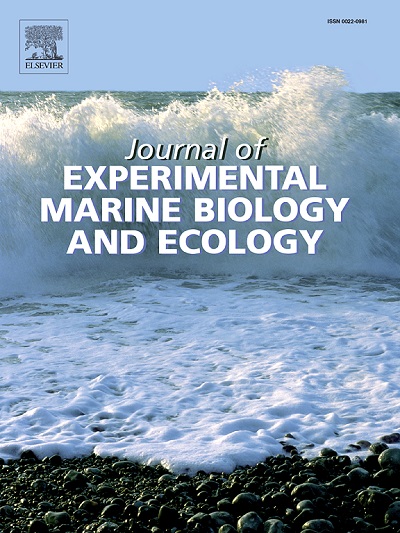光照诱导倒挂水母Cassiopea sp.及其内共生甲藻的表型可塑性
IF 1.8
3区 生物学
Q3 ECOLOGY
Journal of Experimental Marine Biology and Ecology
Pub Date : 2024-11-05
DOI:10.1016/j.jembe.2024.152068
引用次数: 0
摘要
倒挂金钟水母(Cassiopea)是一种越来越受欢迎的模式生物,其共生双鞭毛藻科(Symbiodiniaceae)的内共生双鞭毛藻及其与环境线索相关的钟状脉动行为变化日益受到重视。脉动为了解宿主对环境条件的反应提供了一个独特的窗口,而宿主对环境条件的反应是其他共生刺胞动物通常难以接触到的。脉动还被假定为对内生共生组合起调节作用,但这种调节作用的大小还不十分清楚。在这里,我们利用两个光适应实验来帮助厘清刺胞动物宿主及其内共生甲藻的复杂表型反应。第一个实验研究了 Cassiopea sp.对重复环境光适应试验的表型可塑性(大小、行为、颜色),以确定表型可塑性的速度和幅度。第二项实验比较了三个实验组中水母的适应反应,以检验短适应时间是否会破坏宿主与内共生体关系的稳定性。我们的目标是确定宿主-内共生体的共生表型,从而对这种关系的动态有新的认识。我们采用流式细胞表型分析法对内共生甲藻进行高通量表型鉴定,并利用脉冲幅度调制(PAM)荧光测定法鉴定光合效率(Fv/Fm)。宿主表型对光暗周期的反应是可预测的,在持续光照条件下暴露九到十二天后,宿主表型趋于稳定。然而,中断这一适应期会影响全生物体的表型特征。我们还发现,宿主和内共生体的表型反应通常是分离的,这表明光照条件对表型的调控反应强于宿主对内共生体组合可能采取的调控策略。这项研究为倒挂水母的适应策略提供了独特的见解,倒挂水母是研究刺胞动物-鞭毛虫共生的一个新兴模型。本文章由计算机程序翻译,如有差异,请以英文原文为准。
Light exposure induces phenotypic plasticity of the upside-down jellyfish Cassiopea sp. and its endosymbiotic dinoflagellates
The upside-down jellyfish, Cassiopea, is an increasingly popular model organism gaining prominence for both its endosymbiotic dinoflagellates from the family Symbiodiniaceae and its behavioral changes of bell pulsations associated with environmental cues. Pulsation provides a unique window into the host's response to environmental conditions, a typically difficult to access component of other symbiotic cnidarians. Pulsation has also been hypothesized to play a regulatory role on the endosymbiotic assemblage, but the magnitude of this regulatory effect is not well understood. Here, we used two light-acclimation experiments to help disentangle the complex phenotypic responses of the cnidarian host and its endosymbiotic dinoflagellates. The first experiment examined the phenotypic plasticity (size, behavior, color) of Cassiopea sp. in response to repeated ambient light acclimation trials to determine the rate and magnitude of phenotypic plasticity. The second experiment compared the acclimation response of jellyfish across three experimental groups to test whether a short acclimation time destabilized the host-endosymbiont relationship. Our goal was to identify covarying host-endosymbiont phenotypes to gain new insights into the dynamics of this relationship. We employed flow cytometric phenotypic profiling for high-throughput phenotypic characterization of endosymbiotic dinoflagellates in addition to pulse-amplitude modulated (PAM) fluorometry to characterize photosynthetic efficiency (Fv/Fm). Host phenotypes responded predictably to light-dark cycles and stabilized after nine to twelve days of exposure to consistent light conditions. However, disruption of this acclimation period affected the holobiont's phenotypic profile. We also found evidence that phenotypic responses of the host and endosymbionts were generally decoupled, indicating a stronger regulatory response of light conditions on phenotypes than possible host-regulatory strategies on the endosymbiotic assemblage. This study provides unique insights into the acclimation strategies of upside-down jellyfish, an emerging model for the study of cnidarian-dinoflagellate symbiosis.
求助全文
通过发布文献求助,成功后即可免费获取论文全文。
去求助
来源期刊
CiteScore
4.30
自引率
0.00%
发文量
98
审稿时长
14 weeks
期刊介绍:
The Journal of Experimental Marine Biology and Ecology provides a forum for experimental ecological research on marine organisms in relation to their environment. Topic areas include studies that focus on biochemistry, physiology, behavior, genetics, and ecological theory. The main emphasis of the Journal lies in hypothesis driven experimental work, both from the laboratory and the field. Natural experiments or descriptive studies that elucidate fundamental ecological processes are welcome. Submissions should have a broad ecological framework beyond the specific study organism or geographic region.
Short communications that highlight emerging issues and exciting discoveries within five printed pages will receive a rapid turnaround. Papers describing important new analytical, computational, experimental and theoretical techniques and methods are encouraged and will be highlighted as Methodological Advances. We welcome proposals for Review Papers synthesizing a specific field within marine ecology. Finally, the journal aims to publish Special Issues at regular intervals synthesizing a particular field of marine science. All printed papers undergo a peer review process before being accepted and will receive a first decision within three months.

 求助内容:
求助内容: 应助结果提醒方式:
应助结果提醒方式:


